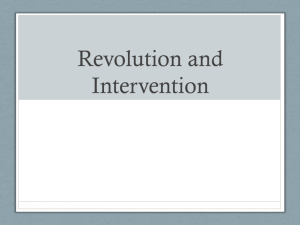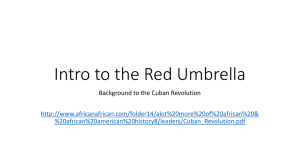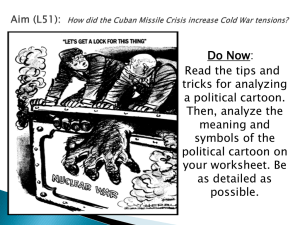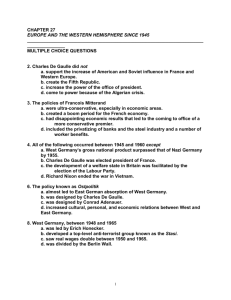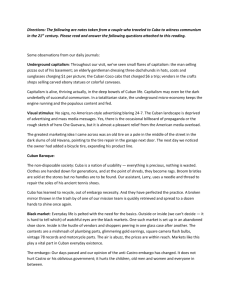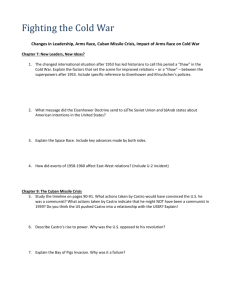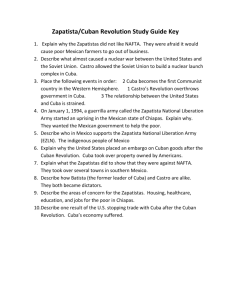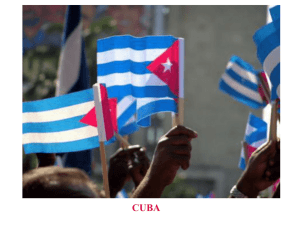The Cuban Revolution July 26, 1953
advertisement
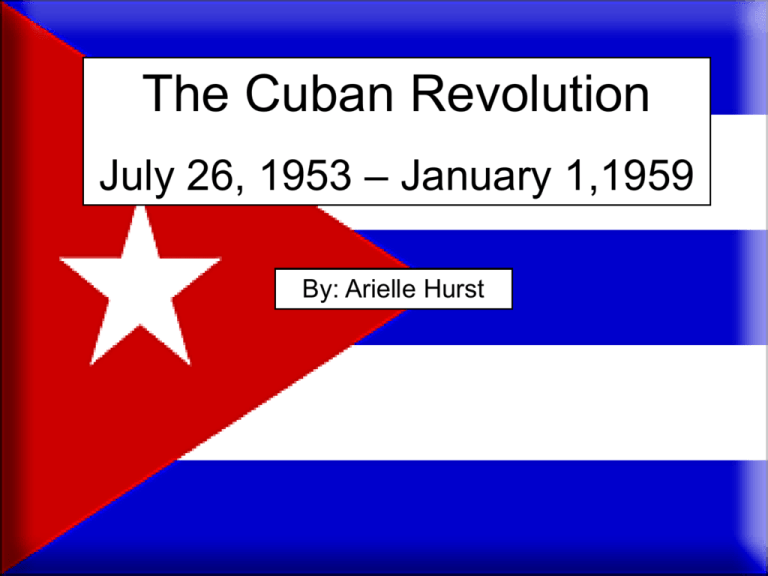
The Cuban Revolution July 26, 1953 – January 1,1959 By: Arielle Hurst Timeline March 10,1952: Fulgencio Batista seizes power July 26,1953: Around one hundred guerrillas (including Fidel Castro and his brother) attack the Moncada Barracks; all were arrested and sentenced May 1955: Castro and others are released from prison June 1955: Castro meets Ernesto Che Guevara November 25, 1956: Castro, Che Guevara, and others set sail on a yacht, Granma December 2, 1956: Granma lands Timeline (Cont.) March 13, 1957: Student Revolutionary Directorate attempts an unsuccessful plot to assassinate Batista May 1958: Batista sends an army to stop Castro and his guerrillas May 1958-December 1958: Several battles occur between Batista’s army and Castro’s guerrillas January 1, 1959: Batista flees Cuba for the Dominican Republic; known as the end of the Cuban Revolution Origin The Cuban Revolution was caused by the takeover of former president Fulgencio Batista. Even though he had the support of the U.S., many Cubans opposed him. One of them was an outspoken lawyer, Fidel Castro. He decided to take action against Batista and the government on July 23, 1953, by leading approximately one hundred guerrillas to attack the Moncada Barracks. This event started the Cuban Revolution. Moncada Barracks History o o o o o Before the Cuban Revolution, Cuba elected Fulgencio Batista as their 14th president. After Batista finished his term, he made attempts to become president again. On March 10, 1952, Batista seized power and canceled all elections, in which he was a candidate. In response to Batista’s actions, Fidel Castro, a lawyer, led roughly one hundred guerrillas, including Castro’s brother Raúl, to attack the Moncada Barracks. This was called the 26th of July Movement. Castro’s revolt was crushed and he was sentenced to 15 years in prison. In 1954, Batista became president since he was the only candidate and the next year, he released all political prisoners, which included Fidel Castro. Raúl and Fidel went into exile and met Ernesto Che Guevara in Mexico City in June 1955. Together, they came up with a plan to overthrow Batista. History (Cont.) o o o o They formed a group and returned to Cuba in November 1956 on a small yacht, Granma. They arrived at a location that was more east than they had planned on December 2, 1956. Shortly after they exited the ship and began hiking to the Sierra Maestra mountains, Castro’s group was attacked and only a small group survived. All who survived regrouped and continued to hike to the Sierra Maestra mountains. Months later, the Student Revolutionary Directorate stormed the Presidential Palace in an attempt to assassinate President Fulgencio Batista on March 13, 1957. Yet, most were killed, including their leader Jose Antonio Echeverria. From that time until the middle of 1958, Castro launched several attacks in the Sierra Maestra mountains, killing Batista loyalists and possible threats to Castro. This resulted in the military control of the mountains. Batista eventually tried to fight back in the Battle of La Plata and the Battle of Las Mercedes. Yet, Castro won the Battle of La Plata and escaped capture in the Battle of Las Mercedes. History (Cont.) o Celebration of Cuban Revolution Next, Castro’s group captured numerous cities. As Castro’s group increased and began to take over, Batista’s panic rose. He fled to the Dominican Republic on January 1, 1959. This action became known as the overthrow of Batista as well as the end of the Cuban Revolution. Fulgencio Batista Fulgencio Batista y Zaldívar was born on January 16, 1901 in Banes, Cuba to Belisario Batista Palermo and Carmela Zaldívar González, Cubans who fought for independence in Spain. He joined the army in 1921 as a private. Due to his hard work and dedication, he became a sergeant in 1932. On January 14, 1934, Batista forced Cuban president Ramón Grau San Martín to resign and appointed Carlos Mendieta to the presidency. Within five days, The United States recognized and supported Cuba’s new government. Fulgencio Batista Fulgencio Batista (Cont.) For the next decade, Batista ruled Cuba from the background until 1940 when he was elected as Cuba’s 14th president. However, in 1944 Ramón Grau San Martín was elected as president again and Batista was forced to relinquish control. Batista worked devotedly to become president again. His chance came on March 10, 1952, when he was elected as president over the former Cuban president, Carlos Prío Socorras. Batista struggled to uphold the Cuban citizens’ and the United States’s trust due to his changes. One day, July 26, 1953, an attack commenced on the Moncada Barracks. This began the Cuban Revolution. On January 1, 1959, Batista panicked and fled to the Dominican Republic. His action led to the end of the Cuban Revolution. Fulgencio Batista died on August 6 1973, in Estoril, Portugal. Fidel Castro Fidel Castro Fidel Alejandro Castro Ruz was born on August 13, 1926 near Birán in Cuba’s eastern Oriente province to Ángel Castro and Lina Ruz. Castro started at a Jesuit school in 1933.He did very well with academics and sports. In 1945, Castro began Law School at the University of Havana, where student gangs were common. Castro associated with a gang called the Unión Insurreccional Revolucionaria. Fidel Castro (Cont.) Castro’s experience with revolution first began in 1947 when he temporarily left law school to join an expedition to overthrow the Dominican dictator, Rafael Trujillo. Next, he participated in the Bogotazo, several riots in Bogotá, Columbia. Afterwards, he returned to law school. In 1950, Castro graduated with a doctorate in law. Castro began the Cuban Revolution when he launched the 26th of July Movement. Castro became the prime minister of Cuba on February 16, 1959 and the president of Cuba on December 2, 1976. Fidel Castro is still alive today. Ernesto Che Guevara Ernesto Guevara de la Serna was born on June 14, 1928, in Rosario, Argentina. Guevara excelled as an athlete throughout his childhood. In 1948, Guevara entered the University of Buenos Aires to study medicine. Guevara took a year off from school to take a trip by motorcycle in South Africa. Guevara took notes and had them published as The Motorcycle Diaries, which became a New York Times best-seller . This gave him the desire of revolution. Guevara graduated from the University of Buenos Aires on June 12, 1953. Ernesto Che Guevara Ernesto Che Guevara (Cont.) After graduating, Guevara became politically active in Argentina then traveled to Bolivia and Guatemala to help there as well. In 1954, Guevara met Castro in Mexico and helped his efforts with The Cuban Revolution. After The Cuban Revolution, Guevara was appointed supreme prosecutor at La Cabaña Fortress due to his help during the Cuban Revolution. Also, Guevara became president at a Cuban bank and was appointed the minister of industry. In 1966, Guevara tried to help the Bolivian people to revolt against the government but failed and was killed in La Higuera on October 9, 1967 by the Bolivian army. Conclusion o o o o o Parade for Fidel Castro o Everything changed after the Cuban Revolution. Batista’s soldiers, policemen, and agents were tried and executed. Manuel Urrutia Lleó became president and José Miró Cardona became the prime minister. Che Guevara was appointed supreme prosecutor at La Cabaña Fortress due to his help during the Cuban Revolution. Castro became the Commander-in-Chief, but when Cardona resigned the next month, Castro became the prime minister. This new government was well accepted and valued. Geographic Location The Cuban Revolution took place in the country of Cuba. This includes areas such as Havana, Sierra Maestra, and Santa Clara. Cuba History Will Absolve Me: Conclusion • This speech was made by Fidel Castro before his sentencing for his attack on the Moncada Barracks. This is only the conclusion. I come to the close of my defense plea but I will not end it as lawyers usually do, asking that the accused be freed. I cannot ask freedom for myself while my comrades are already suffering in the ignominious prison of the Isle of Pines. Send me there to join them and to share their fate. It is understandable that honest men should be dead or in prison in a Republic where the President is a criminal and a thief. History Will Absolve Me (Cont.) To you, Honorable Judges, my sincere gratitude for having allowed me to express myself free from contemptible restrictions. I hold no bitterness towards you, I recognize that in certain aspects you have been humane, and I know that the Chief Judge of this Court, a man of impeccable private life, cannot disguise his repugnance at the current state of affairs that compels him to dictate unjust decisions. Still, a more serious problem remains for the Court of Appeals: the indictments arising from the murders of seventy men, that is to say, the greatest massacre we have ever known. History Will Absolve Me (Cont.) The guilty continue at liberty and with weapons in their hands - weapons which continually threaten the lives of all citizens. If all the weight of the law does not fall upon the guilty because of cowardice or because of domination of the courts, and if then all the judges do not resign, I pity your honor. And I regret the unprecedented shame that will fall upon the Judicial Power. I know that imprisonment will be harder for me than it has ever been for anyone, filled with cowardly threats and hideous cruelty. But I do not fear prison, as I do not fear the fury of the miserable tyrant who took the lives of 70 of my comrades. Condemn me. It does not matter. History will absolve me. Works Cited "Rayne, Trevor. "History of the Cuban Revolution." 28 Apr. 2008 <http://www.rcgfrfi.easynet.co.uk/ratb/cuba/cuba_rev.ht m> “Cuban Revolution." ThinkQuest. 17 May 1999. 18 Apr. 2008 <http://library.thinkquest.org/20176/crevolution.htm>. "Cuban Revolution." 2005. 28 Apr. 2008 <http://unimaps.com/cuba-revolution/print.html>. "History Will Absolve Me." Marxists Internet Archive. 1 May 2008 <http://www.marxists.org/history/cuba/archive/castro/19 53/10/16.htm>. "Timeline: Cuba." BBC. 26 Feb. 2008. 19 Apr. 2008 <http://news.bbc.co.uk/1/hi/world/americas/country_prof iles/1203355.stm>.
